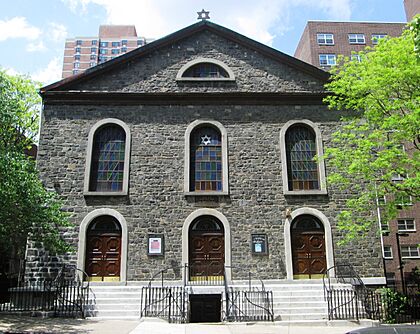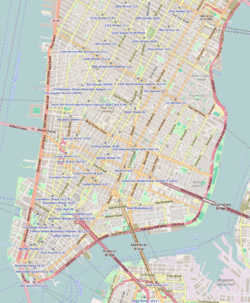Bialystoker Synagogue facts for kids
Quick facts for kids Bialystoker Synagogue |
|
|---|---|

Bialystoker Synagogue in 2013
|
|
| Religion | |
| Affiliation | Orthodox Judaism |
| Ecclesiastical or organizational status | |
| Leadership | Rabbi Menachem Tuchman |
| Status | Active |
| Location | |
| Location | 7-13 Bialystoker Place, Manhattan, New York City, New York |
| Country | United States |
| Architecture | |
| Architectural type | Church |
| Architectural style | Federal |
| Date established | 1865 (as a congregation) |
| Completed |
|
| Materials | Manhattan schist |
The Bialystoker Synagogue is an Orthodox Jewish synagogue located in Manhattan, New York City. You can find it at 7–11 Bialystoker Place, also known as Willett Street, on the Lower East Side. The building was first built in 1826 as a church called the Willett Street Methodist Episcopal Church. The Jewish community bought the building in 1905 and turned it into a synagogue.
This synagogue was named a New York City Landmark in 1966. It is one of only four religious buildings from the early 1800s in Lower Manhattan that are still standing. It is also the oldest building used as a synagogue in New York City.
Contents
The Congregation's History
How the Synagogue Started
The Bialystoker Synagogue began in 1865. It was first known as the Chevra Anshei Chesed of Bialystok. This group was formed by Jewish people who came from a town called Białystok. At that time, Białystok was part of the Russian Empire, but today it is in Poland.
The group first met in a building on Hester Street. Later, they moved to Orchard Street. Finally, they settled at their current home on Bialystoker Place.
Growing the Community
Many new immigrants from the Białystok area of Poland arrived in New York. To welcome them, the original group joined with another congregation from Białystok called Adas Yeshurun in 1905. Together, they formed the Beit Ha-Knesset Anshei Bialystok, which means The Bialystoker Synagogue.
The new, larger congregation then bought the Willett Street Methodist Episcopal Church building. This is the building they still use today. During the Great Depression, a time when many people faced economic hardship, the community decided to make the main prayer hall more beautiful. This was done to give people hope and inspiration.
The Synagogue Today
Today, the Bialystoker Synagogue is the largest synagogue on the Lower East Side. It holds several daily prayer services, known as minyanim. Rabbi Menachem Tuchman is the current rabbi (religious leader) of the synagogue.
Building Design and Features
Architecture of the Building
The synagogue building was originally a church, built in 1826. It has a simple roof with a triangular shape and round-arched windows. The building is made from a type of rock called Manhattan schist. This stone came from a quarry on nearby Pitt Street.
The outside of the building has three windows above three doors. These doors are framed with round arches. There are also a few brownstone steps leading up to the entrance. The roof is gently sloped and has a small, half-circle window.
Special Interior Details
Inside, you'll find a very detailed Torah Ark. This is a special cabinet where the Torah scrolls are kept. Many people believe it was carved in Białystok and then shipped all the way to New York.
Because it is an Orthodox Jewish synagogue, there is a special balcony section for women. This allows men and women to pray separately, which is a tradition in Orthodox Judaism.
A Secret History
In a corner of the women's balcony, there is a small, hidden door. This door leads to a ladder that goes up to an attic. The attic has two windows that let in light. When the building was first opened, it was a safe place for the Underground Railroad. This was a secret network that helped enslaved people escape to freedom. Runaway slaves found safety and shelter in this attic.
Modern Updates
In the 1990s, the synagogue updated its air conditioning system. Because the building is a historical landmark, there were rules about putting cooling units on the roof. To follow these rules, the cooling units were installed on the side of the building instead.
Recent Activities
In 1988, the congregation worked to restore the inside of the synagogue. They made it look as grand as it did when it was first built. The old Hebrew school building next door, which had fallen into disrepair, was also renovated. It reopened as The Daniel Potkorony Building. The beautiful stained glass windows in the synagogue were also completely remade and restored recently.
Gallery
See also
 In Spanish: Sinagoga Bialystoker para niños
In Spanish: Sinagoga Bialystoker para niños
- Kossar's Bialystoker Kuchen Bakery
- Bugsy Siegel Memorial
- List of New York City Designated Landmarks in Manhattan below 14th Street
- National Register of Historic Places listings in Manhattan below 14th Street




